Today in History: April 26
"A Park is A Work of Art"
Frederick Law Olmsted, "Address to Prospect Park Scientific Association,"
The Papers of Frederick Law Olmsted, Supplementary Vol. I
ed. Charles E. Beveridge and Carolyn Hoffman
(Baltimore: Johns Hopkins University Press, 1997) page 155.

Frederick Law Olmsted,
engraved by T. Johnson from a photograph by James Notman, October 1893.
The Evolution of the Conservation Movement, 1850-1920
Frederick Law Olmsted, nineteenth-century America's foremost landscape architect, was born on April 26, 1822. Son of a well-to-do Hartford, Connecticut merchant, Olmsted spent much of his childhood enjoying rural New England scenery. Weakened eyesight forced him to abandon plans to attend Yale. Instead, young Olmsted studied engineering and scientific farming, putting his agricultural and managerial theories into practice on his own Staten Island farm.
A tour of England and the Continent inspired Walks and Talks of an American Farmer in England (1852) and a new career in journalism. Later that year, New York Daily Times editor Henry J. Raymond engaged Olmsted to report on conditions in the slave-holding states. His articles, later published as A Journey in the Seaboard Slave States, undercut prevailing myths about Southern aristocratic refinement with keen observations about the plantation system and its effects on master and slave.
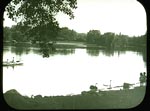
The Lake, Central Park, New York, New York.
American Landscape and Architectural Design, 1850-1920
By the late 1850s, the publishing house Olmsted joined had gone bankrupt, disappointing his hopes for a literary life. Encouraged to apply for the superintendency of New York City's nascent Central Park, Olmsted embarked on a new career that tapped his considerable managerial skills and his knowledge of engineering and horticulture while providing an opportunity to recreate many of the beautiful landscape effects he had seen at home and abroad.
Olmsted was engaged in clearing the 750-acre Manhattan site when architect Calvert Vaux suggested collaborating on a plan for the design competition. Their winning "Greensward Plan" allowed New Yorkers to experience a day in the country without leaving the island city.
Creating this pastoral setting required shifting nearly 5 million cubic yards of dirt, blasting rock with 260 tons of gunpowder, and planting 270,000 trees and shrubs. Completed in 1864, visitors to Central Park still enjoy vistas across the sheep meadow, strolling along wooded paths, climbing The Ramble, and people watching on the terraces and promenades Olmsted and Vaux provided. The Greensward Plan included innovative transverse roads which allowed commuter and commercial traffic to pass through the park on lanes constructed below the grade of park thoroughfares. Equally thoughtful, Olmsted and Vaux provided ample but distinct pedestrian paths and carriage roads so visitors could move through the landscape without fear of collision.
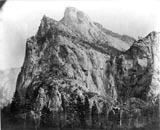
Bridalveil Fall from Cathedral Trail, Yosemite National Park, California,
Carleton E. Watkins, photographer, circa 1860.
The Evolution of the Conservation Movement, 1850-1920
After the outbreak of the Civil War, Olmsted requested a leave of absence from his work as architect-in-chief of Central Park to serve as general secretary of the newly formed Sanitary Commission. Responsible for collecting supplies and directing them into the battlefield, the Sanitary Commission was created to aid transition of the military from a small professional force to a large and geographically dispersed volunteer army. Olmsted worked tirelessly to develop an organizational framework that would meet the needs of the soldier in the field. He considered his two years with the Sanitary Commission his most significant public service.
In 1863, Olmsted's renowned administrative abilities brought an opportunity to manage California gold mines, formerly owned by John C.Frémont. He did not confine his activities to the Mariposa mines, however. Appointed one of the first Yosemite Park Commissioners, his task was to protect, rather than create, an exquisite natural setting. In his Draft of Preliminary Report upon the Yosemite and Big Tree Grove, Olmsted held democratic governments morally responsible for preserving extraordinary landscapes for the benefit of the people. Later, his Special Report of New York State Survey on the Preservation of the Scenery of Niagara Falls (1880) played an important role in convincing New York legislators to purchase and hold Niagara Falls as a public reserve.
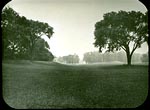
Prospect Park, Brooklyn, New York.
American Landscape and Architectural Design, 1850-1920
After two years in California, Olmsted returned to New York and his partnership with Calvert Vaux. Together they designed Brooklyn's Prospect Park, and ventured into urban planning with a design for the Chicago suburb of Riverside, Illinois. Abandoning his partnership with Vaux in 1872, he went on to design parks and park systems in Detroit, Rochester, Buffalo, and Boston. After a working life that continued into his seventies, Frederick Law Olmsted died in 1903.
Use the following American Memory collections to learn more about the life and times of Frederick Law Olmsted:
- Two important design projects dominated Olmsted's final years: his design for the grounds of the 1893 World's Columbian Exposition and the landscaping of Biltmore, George Washington Vanderbilt's extensive North Carolina estate. Search across American Memory pictorial collections on World's Columbian Exposition and Biltmore to access photos and plans related to these jobs.
- View films made in turn-of-the-century Central Park. Skating on Lake, Central Park, is available through Early Motion Pictures, while Sleighing Scene and Mounted Police Charge can be seen through the collection Inventing Entertainment: The Motion Pictures and Sound Recordings of the Edison Companies.
- Search on the term Central Park in Small-Town America, 1850-1920. See, for example, a group of 102 stereographs taken by photographer Thomas C. Rochefor during the summer of 1863.
- Visit the collection The Evolution of the Conservation Movement, 1850-1920 to learn more about early efforts to preserve the American landscape.
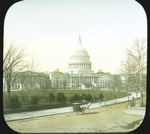
Capitol Building from the Front, Washington, D.C., date unknown.
American Landscape and Architectural Design, 1850-1920
In 1874 Frederick Law Olmsted was commissioned to plan and oversee the renovation of the U.S. Capitol grounds. He had marble terraces constructed on the north, west, and south sides of the building to cause it to "gain greatly in the supreme qualities of stability, endurance, and repose." He developed an architectural treasure known as the Summer House to give visitors a meditative place to rest; planted over seven thousand trees and shrubs along with other vegetation; and laid curved foot paths and roads across the grounds. He also employed ornamental iron trellises, low stone walls, and light stands for functional and decorative purposes. Olmsted retired from supervising the terrace project in 1885 but continued until 1889 to direct work on the grounds.
Shakespeare and the Folger
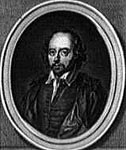
Portrait of Shakespeare and First Page of A Biography [detail], Folger Library Copy Work,
Theodor Horydczak, photographer, circa 1920-ca. 1950.
Washington as It Was, 1923-1959
William Shakespeare was baptized on April 26, 1564, in the town of Stratford-upon-Avon, England. As customary, the entry in the baptismal registry of Holy Trinity Church announces the event in Latin: "Gulielmus filius Johannes Shakspere."
The poet's birthday is traditionally celebrated on April 23 because babies generally were baptized about three days after birth. Shakespeare died on April 23, 1616, and is buried in the church where he was christened.
Although contemporary references to William Shakespeare and his family abound, the first biography of the playwright appeared in the early 18th century. In 1714, Nicholas Rowe published Some account of the life, &c., of Mr. William Shakespear, one of many rare books in the collection of the Folger Shakespeare Memorial Library.
A Library of Congress neighbor on Capitol Hill, the Folger Shakespeare Memorial Library was built and endowed by Henry and Emily Folger to house and maintain a valuable Shakespeare collection they bequeathed to the American people. Completed in 1932, the building is made entirely of American materials, including a neoclassical exterior of Georgia marble and a Tudor interior of Appalachian oak. Shakespearean scholars come from all over the world to use the Folger's rich holdings related to Shakespeare and his times.
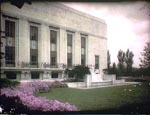
Front of Folger Library, Washington, D.C.,
Theodor Horydczak, photographer, circa 1920-ca. 1950.
Washington as It Was, 1923-1959
- Search on Folger in Washington as It Was, 1923-1959 for pictures of the Folger library building and its architectural decorations, rare items in the collection, and people associated with the early days of the Library's foundation. This collection includes an image depicting a scene from Shakespeare's tragedy Macbeth as it is carved along the exterior wall of the Library.
- Shakespeare's play Macbeth, was produced by John Houseman and directed by Orson Welles for the Federal Theatre Project (FTP) of the Works Progress Administration (WPA) in 1936. See Today in History for July 25 or visit the collection The New Deal Stage, 1935-1939 for more information about that historic production featuring an all African-American cast.
- Search on the keyword Shakespeare in Map Collections (1500-Present) to locate a 1908 tourist map that provides a cartographically accurate bird's-eye view of the Bard's hometown. Click on the map then zoom into landmards such as Shakespeare's birthplace and Holy Trinity Church, the site of his baptism and burial.